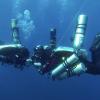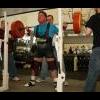
Your Manifold - open or closed
#16

Posted 24 September 2008 - 11:13 AM
#17

Posted 24 September 2008 - 11:23 AM
This is a great topic with a lot of good information, especially as I'm looking to double up two of my 112's next season. Thanks everyone.
Please bear in mind that there are many ways to do things, and that my way is always right...
#18

Posted 24 September 2008 - 01:03 PM
LOL PF!! [however...Moderator conundrum....do I abuse the power and change the word "my" to Dive Girl's...it's like a devil on one shoulder and an angel on the other...Please bear in mind that there are many ways to do things, and that my way is always right...
Once in a while, it is good to step back, take a breath, and remember to be humble. You'll never know it all - ScubaDadMiami. If you aren't afraid of dying, there is nothing you can't achieve - Lao-tzu. One dog barks at something, the rest bark at him - Chinese Proverb.
#19

Posted 24 September 2008 - 01:14 PM
#20

Posted 24 September 2008 - 04:06 PM
This is a great topic with a lot of good information, especially as I'm looking to double up two of my 112's next season. Thanks everyone.
Please bear in mind that there are many ways to do things, and that my way is always right...
In this case. . . agreed.
#21

Posted 24 September 2008 - 06:34 PM
And I think this also hits on gas planning too. How much is enough if you have a total failure?
#22

Posted 24 September 2008 - 07:08 PM
#23

Posted 26 September 2008 - 11:31 PM
I went through standard right post, center post, left post shutdown TWICE because I failed to do it slowly enough the first time to isolate the problem, and still didn't lose more than a few hundred PSI.
Perrone ford's quote above caught my attention. I'm not familiar with what "standard right post, center post, left post shutdown" is. I'm a new tech diver (so please be kind) but the way I was taught to identify and deal with a gas leak behind the head always started with the center post. With a leak somewhere behind the head, the steps were:
1. Close the isolation valve (BTW it was to be kept fully open)
2. Look that your SPG (DIR off of left post) and if decreasing you have a left side leak. So you close the left valve. If bubbles stop then reopen the isolation valve and continue breathing off of the primary (right post reg). You have all of the remaining gas in both tanks available. Call the dive
3. If the SPG is not decreasing then you have a right side leak so you switch to the back up second stage (bungeed around the neck) and close the right post. If the bubbles stop then reopen the isolation valve. You have all of the gas in both tanks available, Call the dive.
4. If in steps 3 or 4 the bubbles don't stop, then the leak is upstream of the shutoff valve and can't be stopped by the manifold. so you leave the isolation valve closed and breath off of the leaking side until it is depleted and then switch to the good side.
So my question is...what is "standard right post, center post, left post shutdown"? Standing by. Thanks.
#24

Posted 27 September 2008 - 07:44 AM
<br /><br /><br /><br />
It is this scenario at 200' where the fear factor is dropped with comments such as, do you know how much gas you'll lose at 200' in 10-20 seconds!? Everyone gasps and runs and closes their manifolds. (Note, I have never planned a dive where I would be on my last reserve at 200')<br />4. A valve fails or burst disk blows. Manifold open - you shut down the manifold and switch to functioning regulator with access to its tank of backgas. Manifold closed - you switch to the working regulator and breathe off its tank of backgas.
When I did dive doubles, manifold open, all the time....
A while ago, Curt Bowen performed the following to help answer these questions, http://www.cavediver...amp;postcount=4.
Here is a little test I did at Eagles Nest cave on Feb 12th for a small article to be placed in issue 17 of Advanced Diver Magazine.
The question I wanted to answer was:
How much time would it take to empty a full aluminum 80 cuft cylinder from 3000 psi to 0 for the following situations and would depth affect the times.
1. Failed Burst Disk
2. Failed HP Hose
3. Failed LP Hose
4. Free Flow high performance regulator 2nd stage.
I completed the test on the surface (0 feet) with 4 aluminum 80ís and a Zeagle D50 regulator.
Here are the results
1. Failed Burst Disk = 72 seconds
2. Failed HP Hose = 22 minutes
3. Failed LP Hose = 83 seconds
4. Free Flow High Performance Regulator = 255 seconds
I then repeated the test at 4 atmís / 99ft
1. Failed Burst Disk = Same within a second or 2
2. Failed HP Hose = Same within a minute
3. Failed LP Hose = Same within a second or 2
4. Free Flow High Performance Regulator = 155 seconds
I then repeated the test at 8 atmís / 231ft
1. Failed Burst Disk = Same within a second or 2
2. Failed HP Hose = did not complete due to time restraints but would assume it would be with a minute difference
3. Failed LP Hose = Same within a second or 2
4. Free Flow High Performance Regulator = 91 seconds
So, based on the results one can conclude....
In cases 1-3, depth is not a factor, the fundamental rate of gas loss is determined by the orifice size of the leak... not the depth.
In case 4, the 2nd stage is essentially throttling the rate in test case 3..., which is depth compensating.
#25

Posted 27 September 2008 - 07:51 AM
<br />
LOL PF!! however...Moderator conundrum....do I abuse the power and change the word "my" to Dive Girl's...it's like a devil on one shoulder and an angel on the other...Please bear in mind that there are many ways to do things, and that my way is always right... <img src="style_emoticons/default/teeth.gif" style="vertical-align:middle" emoid="
" border="0" alt="teeth.gif" />
]
Do we really need the angel?
#26

Posted 27 September 2008 - 10:14 AM
A while ago, Curt Bowen performed the following to help answer these questions
I then repeated the test at 4 atmís / 99ft
1. Failed Burst Disk = Same within a second or 2
2. Failed HP Hose = Same within a minute
3. Failed LP Hose = Same within a second or 2
4. Free Flow High Performance Regulator = 155 seconds
...
So, based on the results one can conclude....
In cases 1-3, depth is not a factor, the fundamental rate of gas loss is determined by the orifice size of the leak... not the depth.
In case 4, the 2nd stage is essentially throttling the rate in test case 3..., which is depth compensating.
This compares favorably with my experience with an o-ring failure at the second stage of my backup reg in JB at ~85ft. I was using a non-air balanced regulator, and the gas loss was minimal. There are a LOT of myths out there. And I thank Curt for his testing. Also of note, I had cave filled 108s on my back and had nearly 5 times as much gas as his example. Not including my 80cuft stage bottle.
#27

Posted 28 September 2008 - 11:55 AM
A while ago, Curt Bowen performed the following to help answer these questions
I then repeated the test at 4 atmís / 99ft
1. Failed Burst Disk = Same within a second or 2
2. Failed HP Hose = Same within a minute
3. Failed LP Hose = Same within a second or 2
4. Free Flow High Performance Regulator = 155 seconds
...
So, based on the results one can conclude....
In cases 1-3, depth is not a factor, the fundamental rate of gas loss is determined by the orifice size of the leak... not the depth.
In case 4, the 2nd stage is essentially throttling the rate in test case 3..., which is depth compensating.
This compares favorably with my experience with an o-ring failure at the second stage of my backup reg in JB at ~85ft. I was using a non-air balanced regulator, and the gas loss was minimal. There are a LOT of myths out there. And I thank Curt for his testing. Also of note, I had cave filled 108s on my back and had nearly 5 times as much gas as his example. Not including my 80cuft stage bottle.
When we were in Roatan as we jumped off the boat, I heard this pop and it was my divemasters LP hose. He did the dive complete dive with a leaking hose down to 60 ft for 45 minutes and still had 1000psi in the tank when we finished. Whether it was advisable is certainly questionable, but he did it without a problem. My concern was whether the hole would get worse and expand over time, but he didn't seem to worry about it.
#28

Posted 04 October 2008 - 08:11 PM
#29

Posted 05 October 2008 - 01:07 AM
If you should be unlucky to have to do a shutdown under real conditions, you'll find that "quicker" is not necessarily better.It makes the shutdown drills go quicker too;-)
#30

Posted 05 October 2008 - 11:27 AM
Perrone - thanks for the comment, I'm sure you have a reason - so before I start taking my sweet time - would you mind taking a moment to elaborate?If you should be unlucky to have to do a shutdown under real conditions, you'll find that "quicker" is not necessarily better.It makes the shutdown drills go quicker too;-)
When I took courses from OTWDiver, time was a criteria on valve drills - so now, I am once again corn-fuzed. But as a newbie, and DIMW diver, I'm sure you already had that figured out.... lol
Edited by Capn Jack, 05 October 2008 - 11:29 AM.
Jacques Yves Cousteau
0 user(s) are reading this topic
0 members, 0 guests, 0 anonymous users





















